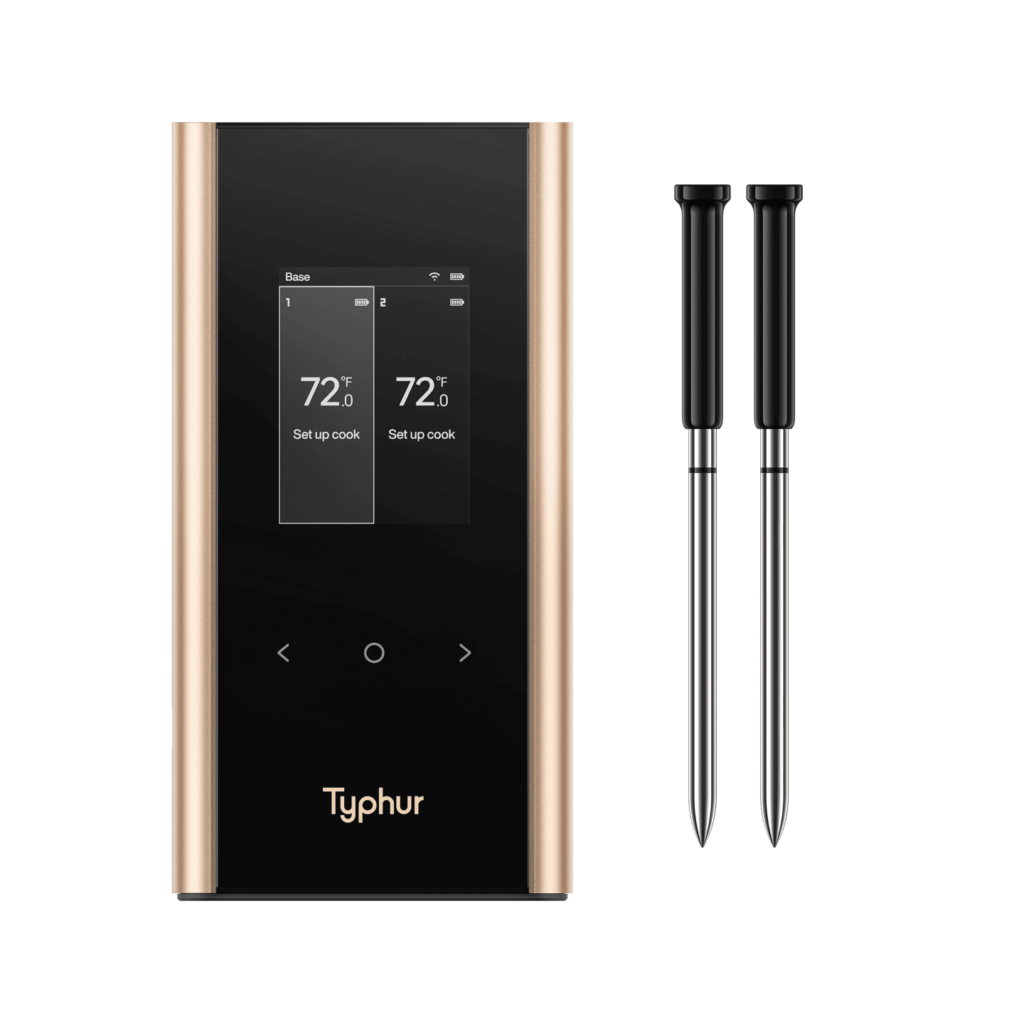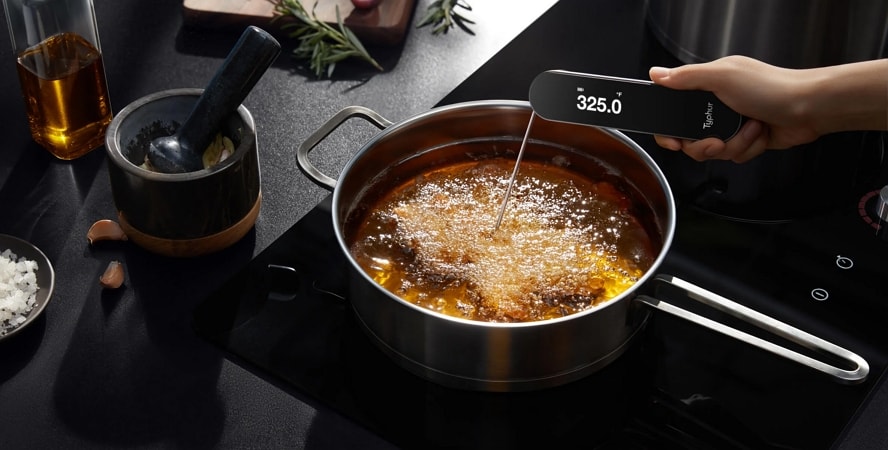If there is any single aspect that can quickly destroy your BBQ dreams, it is slicing into a brisket that is either dry as a cracker or still rubbery inside. One modified step from an hour-long practice of tending a smoker could very well ruin your freshly cooked meal. That is the reason why a meat thermometer for brisket is necessary.
There is no doubt that brisket is a difficult piece to smoke. First, it is a large piece that contains fat and connective tissue, making it a challenging piece to cook well. Smoking brisket is not something that can be guessed; it does not respond to prodding in any useful manner. What it needs is a brisket thermometer to provide the required finesse.

This guide will cover the correct cooking temperatures for brisket, how to use a meat thermometer for brisket properly, which models perform the best, and advanced techniques that ensure your brisket stays moist every single time.
Table of contents
Brisket Cooking Temperatures
Compared to other cuts, brisket requires the most attention. It is a tough cut of meat, so low temperatures over a long period are the only way. Brisket meat thermometers are extremely useful for this.
- Smoking temp: Make sure your smoker is at 225°F (107°C). Steadiness is essential.
- The stall (150–165°F / 65–73°C): The brisket stalls over this temperature range. No need to overreact — just maintain the temperature or wrap it in butcher paper for a gentle transition.
- Target doneness: Keep the smoker at 225℉ (107℃), continue cooking until the internal temperature reaches 200℉ (93℃) in the thickest part of the meat.
- Resting: Allow it to rest while wrapped for 30–60 minutes, by which time it will have cooled down to close to 150°F (65°C). This locks in juices.
When it comes down to it, brisket is all about patience. Stick with the right brisket thermometer temperature markers, and you’ll turn that tough cut into barbecue gold.
How to Use a Meat Thermometer for Brisket
Having the right meat thermometer for brisket is a great start. The real results come from using it properly. Here is a guide that takes the guesswork out of smoking brisket:
1. Trim and Prep Before Probing
Cut off the excess fat and season the brisket. While the meat is still cold, insert your thermometer probe. The meat will be cold, and you will get a cleaner insertion. Also, it will help retain the juices.
2. Probe Placement Matters
Make sure to put the probe in the thickest part of the flat cut. The flat is the leaner portion of the brisket, and the shred slower, which will give you the most accurate reading. Do not put the probe close to fat seams or fat layers, as that will give you inflated or deflated readings that will be misleading.

3. Smoke the Brisket
With the point facing the heat source, place the brisket in the smoker. Seal the lid and smoke low and slow at 225°F (107°C) until the brisket reaches an internal temperature of 165°F (74°C). This usually takes 6–8 hours.
4. Wrap & Continue Cooking
Remove the brisket from the smoker at 165°F. Wrap it tightly in either butcher paper or foil and place it back into the smoker seam-side down. Continue cooking until it reaches 200°F (93°C). If using a connected wireless thermometer, you can set the alerts to notify you when it reaches the desired temperature, so you don’t have to stand beside the smoker.
5. Rest With the Probe In
After the final high alarm goes off, take the brisket out of the smoker. Leave your probe in during the first part of the rest. This allows you to monitor the carryover heat and makes sure the brisket cools slowly to about 150°F, ready for slicing. If the probe is removed too early, it can make the brisket juices flow out.

Pro Tip: If you want to know how to handle wireless meat thermometers for any kind of beef, it's the same approach: the thickest area of the piece, steer clear of fat and bone, and trust the temperature. Brisket, on the other hand, is different because it demands a lot more patience and regularity.
Best Meat Thermometer for Brisket: Typhur Sync Gold Dual
If you want a reliable meat thermometer for brisket, the Typhur Sync Gold Dual is the best choice. It is particularly useful for long and difficult cuts like brisket, where trust and pinpoint accuracy are crucial.

Long Range Wireless Meat Thermometer
- Dual Probes: Keep an eye on your brisket and smoker temperatures simultaneously. Ideal for controlling the stall without lifting the lid.
- Long-Range Wireless: Typhur’s Sub-1GHz wireless technology outperforms Bluetooth for signal stability, even with ceramic Kamado grills or thick steel smokers.
- Ultra Accuracy: Precision is within one degree, so you will never wonder if your brisket is done.
- App Integration: Link the device to the Typhur App, navigate to ‘Beef → Roast → Brisket,’ and set your desired temperature (200°F). The app also guides you when to wrap, rest, and slice.
- Durable Build: Made for hours of use, slippery hands, and high heat.
If you’ve got barbecue on the brain, the Typhur thermometer for brisket eliminates worry and speculation. You can relax and focus on the smoke and seasoning while the thermometer manages precise science.
Expert Tips for Cooking Brisket with a Thermometer

Even if you have the correct brisket thermometer, technique is still the key to success. Here are a few tips from experienced cooks:
- Wrap at the Stall. At 160 to 170 degrees, wrap the brisket in butcher paper or foil. This will allow it to continue cooling while preserving moisture.
- Track Pit Temp Separately. A cooking thermometer for your BBQ smoker is just as crucial as your brisket probe. If the temperature is too high, the brisket will dry out; if too low, cooking will take ages.
- Allow Brisket to Rest. Brisket should not be sliced immediately after reaching the required temperature. Resting the brisket properly, wrapping it in foil, and placing it in a cooler (or oven) helps to retain juices and improve flavour.
- Wireless Tech. Brisket thermometers, such as the Modern Meater, have alarm systems, graph tracking, and app integration. Long-duration cooking no longer requires guesswork.
FAQs About Brisket Thermometers
Insert the probe in the thickest portion of the flat, steering clear of any fat pockets. This area provides the most accurate brisket temperature reading.
You can lift it with tongs. If it bends without much effort, that’s one indicator. Try stabbing it with a skewer—if it slides in with no resistance, it’s close. But honestly, if you don’t have a thermometer, you have very limited information.
Absolutely. A good quality digital meat thermometer, or even the best smoker thermometer, can be used for all types of meat. The only difference is the end temperature. Just make sure you clean the probe after each meat.
Summary
If you’re really into smoking meat, stop guessing the temperature of your brisket. A meat thermometer is not optional, it’s an absolute must. Whether you buy a Typhur meat thermometer or any other, the idea is to work smarter, not harder.
Keep this in mind the next time you use your smoker: brisket is indifferent to the number of videos on cooking it you have watched. It only responds to time and temperature. Get those right, and you’ll have a smoky, tender brisket that will keep friends and family coming back.




